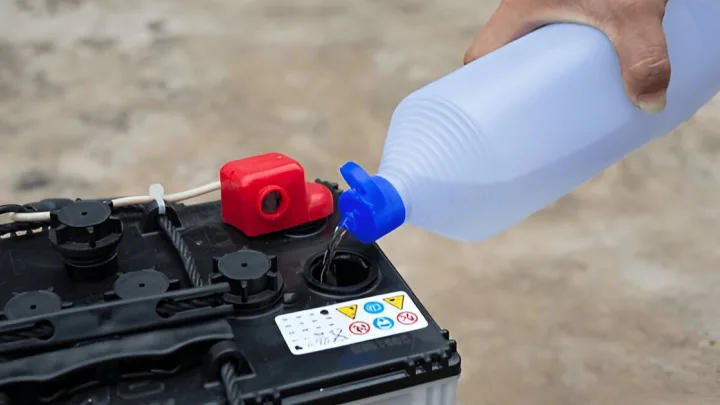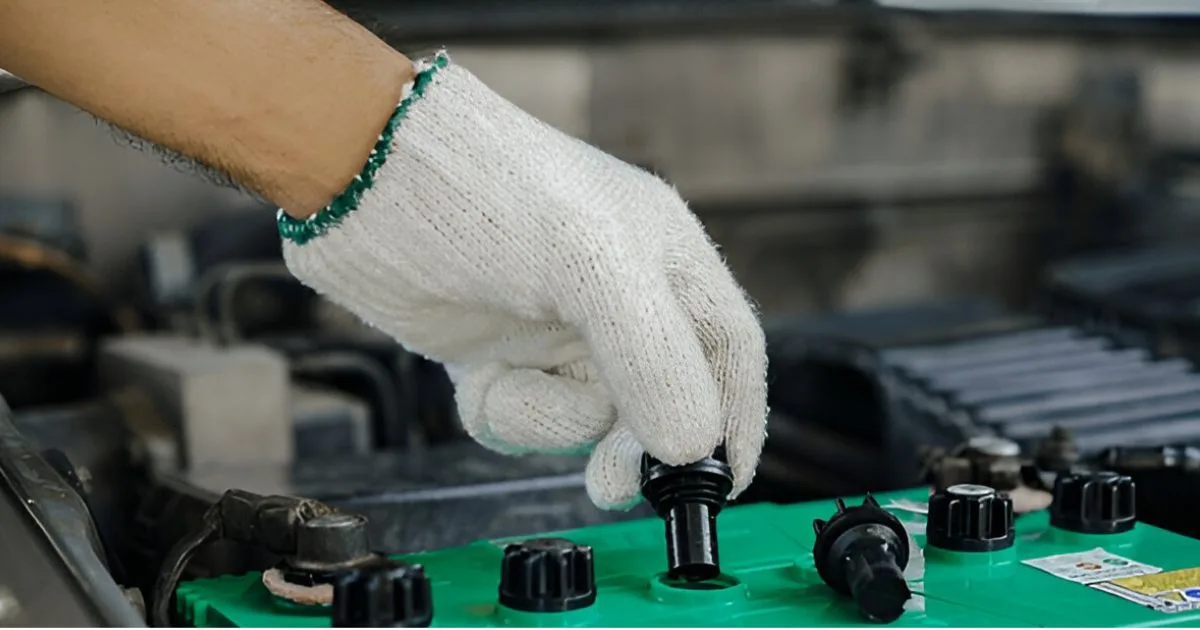
Battery Fill your car battery with enough distilled water to reach the maximum fill line. Do not overfill, as this can cause leakage and damage.
Maintaining the correct level of distilled water in your car battery is crucial for its longevity and performance. Car batteries are designed with a specific water-to-acid ratio that must be preserved for optimal function. Over time, the water within the battery evaporates, and the levels need to be replenished to ensure the electrolytes can properly conduct electricity.
Using distilled water is essential, as it is free from minerals and impurities that could harm the battery cells. Regular checks, especially in hot climates or after extensive use, can prevent battery failure and extend its life. As a car owner, understanding the balance between not enough and too much water is a simple yet important aspect of vehicle maintenance.
Introduction To keeps Car Battery Maintenance Distilled Wate
Regular car battery maintenance ensures peak performance. It involves checking water levels and replenishing distilled water.
The Role Of Water In Car Batteries
Car batteries need water for electrolyte composition. Water helps with electricity flow.
Signs Your Battery Needs Water
- Slow engine crank
- Swollen battery case
- Low water level indicator
 Car Distilled Water Versus Tap Water
Car Distilled Water Versus Tap Water
Car Distilled Water Versus Tap Water
Choosing the right type of water for your car battery is crucial. Distilled water and tap water are not the same. This difference matters a lot for the health of your car battery. Let's explore why.
Impurities And Their Effects On Batteries
Tap water contains minerals and chemicals. These can harm your car battery. Over time, impurities build up. They can lead to:
- Decreased battery life
- Reduced performance
- Potential damage to battery components
Common impurities include:
| Impurity | Effect on Battery |
|---|---|
| Calcium | Decreases capacity |
| Magnesium | Leads to deposits |
| Chlorides | Corrosive effects |
Why Distilled Water Is Recommended
Distilled water is pure. It lacks the harmful impurities found in tap water. This purity makes it ideal for car batteries. Benefits include:
- Longer battery life
- Better performance
- No harmful deposits
Always use distilled water for topping off your car battery. It ensures optimal performance and longevity.
Determining The Right Amount Of Water
Maintaining your car battery is crucial. The right amount of distilled water ensures peak performance. Too little or too much can harm the battery. This guide helps you add the perfect amount of water to your car battery.
Battery Size And Capacity
Car batteries come in different sizes and capacities. Each battery requires a specific water level. Check your battery's manual for the right specifications. Use this information to determine how much distilled water you need.
| Battery Type | Capacity (Ah) | Distilled Water Amount |
|---|---|---|
| Small Car | 36-48 Ah | 120-150 ml |
| Medium Car | 49-60 Ah | 150-175 ml |
| Large Vehicle | 61-100 Ah | 175-250 ml |
Water Level Indicators
Most batteries have built-in indicators for water levels. Look for a mark inside the filling port. This shows the optimal level. Fill slowly until the water reaches this mark. Do not overfill. It can cause leaks and damage.
- Remove cell caps from the battery.
- Check the indicator inside each cell.
- Fill with distilled water, if below the mark.
- Stop at the indicator mark.
- Replace cell caps securely.
Step-by-step Guide To Adding Car Distilled Water
Maintaining your car battery is vital for its longevity. Water levels in a battery can affect performance. Let's dive into the proper steps to add distilled water to your car battery.
Safety Precautions
- Turn off the engine.
- Wear safety goggles and gloves.
- Avoid sparks or flames near the battery.
- Ensure good ventilation in the work area.
Tools And Materials Needed for Car Distilled Water
- Distilled water - prevents mineral build-up.
- Screwdriver - for prying open caps.
- Clean cloth - to wipe any spills.
- Funnel or squeeze bottle - for precise pouring.
Filling Procedure
- Remove battery caps with the screwdriver.
- Check water level. Look for fill lines.
- Use funnel or squeeze bottle to add water.
- Fill just below the maximum line.
- Clean any spills with the cloth.
- Replace caps securely.
When To Add Car Distilled Water To Your Battery
Keeping your car battery hydrated is crucial. It ensures the longevity and performance of the battery. Distilled water is the best choice for this. Knowing when to add water extends battery life.
Routine Maintenance Schedule
Regular checks are vital for a healthy battery. Experts recommend inspecting the battery as part of your routine vehicle maintenance. This should occur every three to six months. A visual inspection can alert you to low water levels. Batteries in hotter climates may need more frequent checks.
After An Electrolyte Check
Perform an electrolyte level check to determine water needs. Use protective gear like gloves and goggles. Remove the battery caps safely. If the water covers the plates, it's sufficient. If not, distilled water is necessary. Only fill to the indicator level. Overfilling can cause damage. Always consult the vehicle's manual for specific guidance. It's best to charge the battery after adding water. This ensures proper mixing of the electrolyte solution.
 Car Distilled Water Common Mistakes To Avoid
Car Distilled Water Common Mistakes To Avoid
Car Distilled Water Common Mistakes To Avoid
Maintaining a car battery is vital for your vehicle's performance. Yet, some car owners make errors while servicing their batteries. Knowing what to avoid can save you time and money.
Overfilling The Battery
Keeping the correct water level in your car battery is essential. Overfilling can lead to acid leaks. This can damage the battery and your car.
- Check the max fill line.
- Add water only to that line.
- Use a proper funnel or battery filler.
Using Non-distilled Water
Tap water contains minerals that can harm battery cells. Always use distilled water to avoid this.
| Water Type | Use for Battery? |
|---|---|
| Distilled Water | Yes |
| Tap Water | No |
| Car Spring Water | No |
Stick to distilled water to keep your battery running smoothly.
 Troubleshooting Battery Car Distilled Water Issues
Troubleshooting Battery Car Distilled Water Issues
Troubleshooting Battery Car Distilled Water Issues
Maintaining the right water level in your car battery is essential. Troubleshooting battery water issues can help your battery last longer. Let's dive into common problems and their solutions.
Dealing With Leaks
Identify the leak - Check for wet spots around the battery. A wet battery often means a leak. Seal it up - Use epoxy for small leaks. For big leaks, consider replacing the battery. Check the cause - Overcharging can cause leaks. Ensure your charging system works well.
Correcting Overfill
Too much water can harm your battery. Follow these steps to fix an overfill:
- Stop adding water - First, don’t add more water.
- Drain excess water - Use a syringe or turkey baster.
- Charge the battery - A full charge helps balance the levels.
Remember, distilled water is best for your battery. It keeps the battery clean and efficient.
Professional Versus Diy Car Distilled Water on battery Maintenance
Maintaining a car battery is crucial for your vehicle's performance. There are two main approaches, professional help and DIY maintenance. Knowing when to choose each can save time and money. This section will guide you through when to seek expert assistance and the advantages of handling battery maintenance yourself.
When To Seek Professional Help
Professional services ensure safety and expertise. Seek help:
- When unfamiliar with battery components
- If the battery fails after adding water
- During complex electrical issues
Experts have the right tools and knowledge. They diagnose issues accurately. This prevents damage to your car's electrical system.
Benefits Of Learning Diy Maintenance
DIY battery maintenance has several benefits:
- It saves money on service costs.
- DIYers gain valuable skills for car care.
- Regular maintenance extends battery life.
Learning to add distilled water to your car battery is simple. Use a funnel and add water until it reaches the fill line. Always wear protective gear and follow the car manual.
Extending Battery Life And Performance
Extending Battery Life and Performance is crucial for car owners. Care for your car battery ensures reliability. Proper maintenance maximizes lifespan and efficiency. One key aspect is knowing how much distilled water to add.
Regular Cleaning Tips on Car Distilled Water
A clean battery prevents corrosion and power loss. Follow these simple steps for regular cleaning:
- Turn off the engine.
- Wear safety gear like gloves and goggles.
- Remove terminals, starting with the negative.
- Clean with a baking soda solution.
- Rinse with distilled water.
- Dry with a clean cloth.
- Reattach terminals, positive first.
Monitoring And Testing Battery Health
Check your battery often to avoid surprises. Use a voltmeter for accurate readings.
- Turn off your car.
- Connect voltmeter red to positive, black to negative.
- Read voltage on the display.
A reading above 12.6 volts indicates a full charge. Below 12.4 volts means you need to recharge.
Test your battery's specific gravity with a hydrometer. A fully charged cell shows 1.265 or higher.
Ensure water levels are correct after testing. Fill with distilled water to the marked levels.
Related Post
How to Test a Car Voltage Regulator With a Multimeter: Quick Guide
What is the Most Common Battery Cable Terminal: Key Insights
Why Sulphuric Acid is Not Used on a Car: Dangers Revealed
Can You Use Aluminum Foil on Car Battery Terminals? Boost Performance!
What Happens When Car Battery Cables are Wrongly Connected: Risks & Fixes
How to Install a Car Battery Holder: Quick & Secure Guide
How Do You Know If Your Car Alternator is Bad? Spot Signs Now!
Conclusion
Maintaining your car battery is crucial for vehicle longevity. Use distilled water to top off cells, but never overfill. Check levels regularly and follow manufacturer guidelines to ensure optimal performance and safety. Remember, a well-cared-for battery means a reliable ride. Drive smart, refill wisely.
Disclosure
Some links may be affiliate links. That means we may earn a small commission at no extra cost to you.